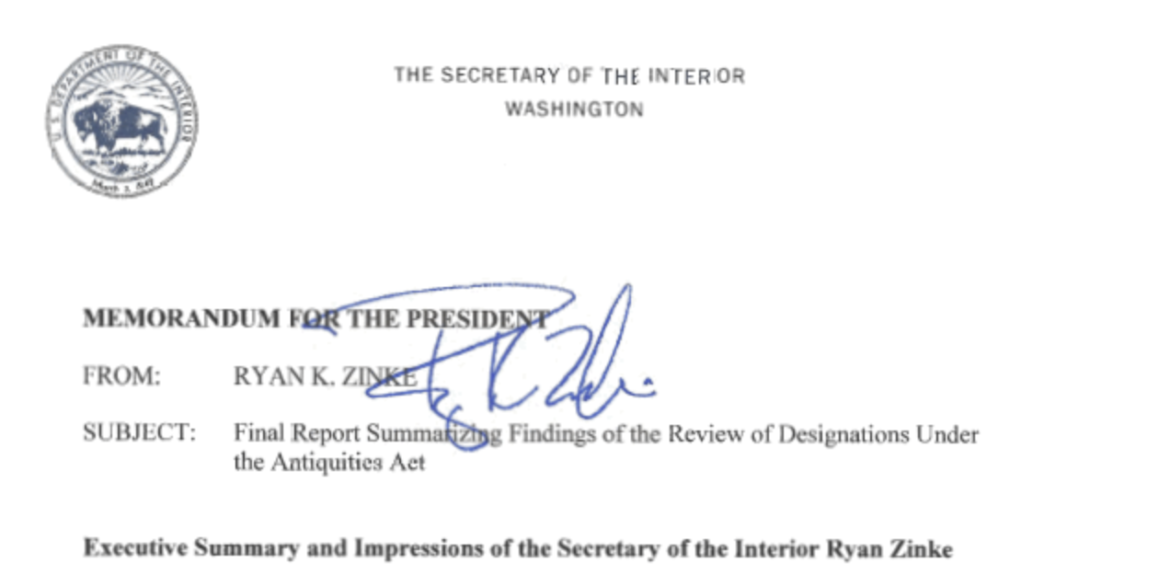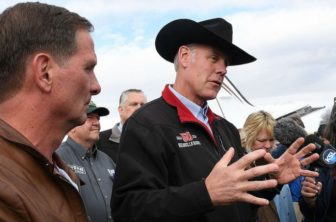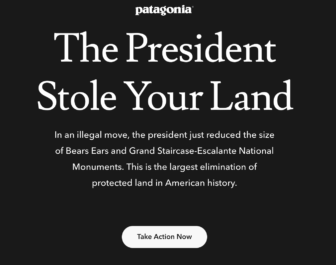
Interior Department
Interior Secretary Zinke has recommended shrinking four National Monuments.
Interior Secretary Ryan Zinke’s controversial review of national monuments is now public. In addition to dramatically shrinking two Utah monuments by more than a million acres, Zinke is adding a monument in Nevada and one in Oregon to the list of those he recommends downsizing. Zinke also wants to amend proclamations on four additional monuments to clarify what activities, such as hunting, grazing and fishing, are allowed.

Interior Department
Interior Secretary Ryan Zinke takes questions during his monument review in Utah.
“America has spoken and public land belongs to the people,” Secretary Zinke said. “As I visited the monuments across this country, I met with Americans on all sides of the issue — from ranchers to conservationists to tribal leaders — and found that we agree on wanting to protect our heritage while still allowing public access to public land. My recommendations to the president reflect that, in some circumstances, proclamations should be amended, boundaries revised, and management plans updated.”
Here are five things you should know about our National Monuments:
#1 It’s all about the Antiquities Act
Secretary Zinke believes past presidents have used the Antiquities Act beyond its intended scope. The act, which was signed into law by President Theodore Roosevelt in 1906, gives the president power to designate national monuments in areas that contain features like historic landmarks, geological formations or archeological sites. But, the act has limits. Monuments, it says, should be confined to “the smallest area compatible with proper care and management of the objects to be protected.” Zinke felt that the original acreage of Bears Ears and Grand Staircase went beyond that “smallest area compatible.” It was a federal overreach to take those lands, he said, limiting activities of people who live and recreate near the monument.
#2 President Trump did not steal land

Patagonia
The outdoor retailer Patagonia has mounted a campaign in favor of the Bears Ears National Monument.
There are some claims that this is what happened, but actually the land within the boundaries of the original Bear’s Ears National Monument and Grand Staircase-Escalante National Monument remain federal lands. In its decision to shrink monument boundaries, the administration removed a layer of protection from the land outside new monument boundaries. That land can now be open to energy development, for example. But those areas will continue to be managed by various Utah Bureau of Land Management (BLM) offices and the Forest Service and will remain available to the public for recreation, hunting, fishing and grazing.
#3 Widespread energy development in Bears Ears is unlikely
Since 2013, oil and gas companies have shown interest in leasing more than 100,000 acres in and around Bears Ears. That’s according to an analysis by the Center For Biological Diversity, which is suing over the decision to shrink the Utah monument. There has been some drilling inside the original monument boundaries, but the last well stopped producing in 1992. Oil and gas producers are working to the east and the north of Bears Ears and, according to the Utah Bureau of Land Management, there are 23 existing oil and gas leases, all at least partially within original monument boundaries. However, experts say that the oil and gas potential deep within the monument is low and that getting those fossil fuels to market from such a remote area could be uneconomic.
#4 Monument designations add additional layers of protection
While the BLM still has to balance a variety of uses across monument landscapes, designations elevate the charge of protecting monument resources above those other uses. Future energy development, for example, is prohibited.
John Ruple, a law professor at the University of Utah, focusing on land issues explains it like this:
“A proclamation like the one President Clinton signed to create the Grand Staircase-Escalante or the one President Obama signed to create Bears Ears identifies a long list of objects to be protected. In the case of both of those monuments, the proclamations also identify activities that could potentially be in conflict with protection, like livestock grazing or off-highway vehicle use, but that will be allowed to continue consistent with the proper care and management of the objects to be identified in the monument proclamation… So, the change (when the original monument designations were made) is two-fold: the designation changes the way resource managers view resources and balance competing demands, and the designation will hopefully open up additional funding to improve resource management.”
When it comes to looting of artifacts, prior to the original designations, resource protection laws may not have been strong enough to prevent these problems. Over the past six years, the federal government investigated at least 27 serious incidents of looting and damage to archaeological sites in the Bears Ears area. In 2009, federal agents issued arrest warrants for 16 people in Blanding, Utah, a town near the monument. That raid ended a two-year sting associated with the thefts of hundreds of ancient Indian artifacts.
#5 Shrinking Or Amending Monument Designations Is Not A Done Deal
The Trump administration already faces multiple lawsuits over the decision to scale down monuments in Utah. Just hours after the announcement, five tribes – Hopi, Navajo Nation, Ute Mountain Ute Tribe, Pueblo of Zuni and Ute Indian – filed suit in U.S. District Court in Washington D.C. These tribes were also part of the Bears Ears Inter-Tribal Coalition, which worked to establish the Bears Ears Monument under President Barack Obama. The suit claims the Antiquities Act gives the president the authority to designate or modify a monument, but not revoke one. There are legal arguments on both sides.
A similar argument is being made in another suit, filed by a group of environmental and conservation organizations, against Trump and Interior Secretary Zinke, for shrinking Grand Staircase-Escalante. The Wilderness Society, the National Resources Defense Council and the Sierra Club joined with seven other groups claiming the decision “exceeds (Trump’s) authority under the US Constitution and the Antiquities Act.”
Directly following Trump’s announcement to shrink Bears Ears, Navajo Nation President Russel Begate said:
“The Navajo Nation has made repeated requests to meet with President Trump on this issue. The Bears Ears Monument is of critical importance, not only to the Navajo Nation but to many tribes in the region. The decision to reduce the size of the Monument is being made with no tribal consultation. The Navajo Nation will defend Bears Ears. The reduction in the size of the Monument leaves us no choice but to litigate this decision.”
What’s Next:
- Check out Inside Energy’s documentary Beyond Standing Rock that chronicled Native American efforts to urge the Obama administration to designate Bear’s Ears as a national monument
- Read more about energy development possibilities within the original monument boundaries
- Reporter Dan Boyce digs in to Ryan Zinke, Roosevelt and the meaning of conservation in his new podcast.







